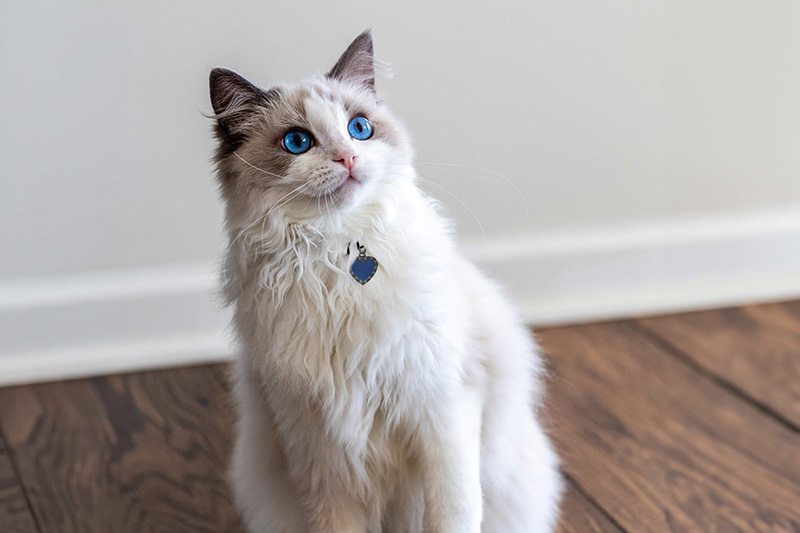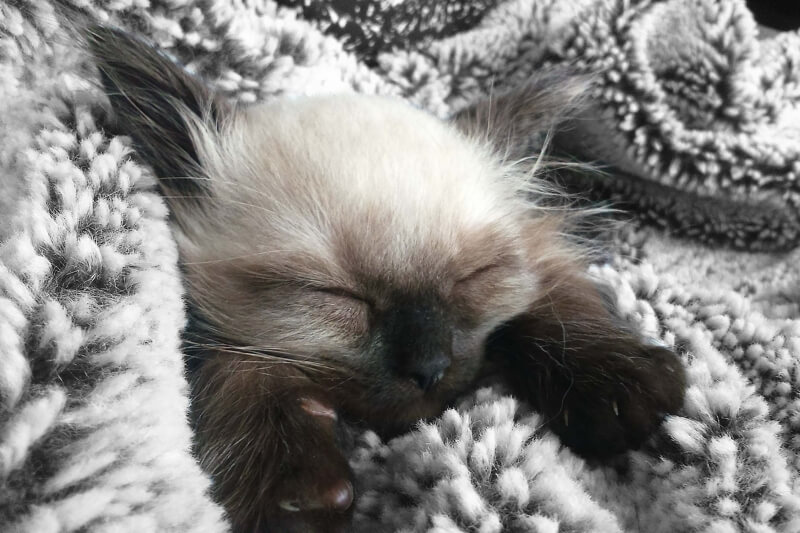
Ragdoll cats are huge, silky and, particularly mysterious. These floppy, puppy-like kitties are personable, incredibly cuddly, and growing in popularity. This popularity comes in spite of their strange origin story, which nearly saw these beautiful fuzzbuckets lost to obscurity. However, a passionate cult following allowed these cats to remain a vibrant part of catdom and a prized breed for many families.
Ragdolls: An Eccentric Origin
The origin of the Ragdoll only extends back to the mid-1960s. That’s when cat breeder Ann Baker of Riverside, CA, became entranced by a half-feral Persian cat named Josephine. The lovely cat was barely tame and mostly hung around Ann’s neighbors. They claimed Josephine as their own.
Josephine’s pet parents clearly weren’t aware of The American Society for the Prevention of Cruelty to Animals® (ASPCA®) recommendations for healthy cats, which include spaying or neutering, and a strictly indoors lifestyle. Sadly, Josephine was injured by a car. Luckily, however, she was nursed back to health by kind neighbors and soon had a litter of kittens.
What does this have to do with today’s Ragdolls? Well, the post-car-accident kittens intrigued Baker. As a breeder of Persians herself, she concluded that Josephine’s kittens had been transformed by the trauma. She postulated that Josephine’s genes had somehow been rearranged in the incident, making her kittens docile, calm and overly friendly. Baker believed that it was also possible that Josephine’s genes had somehow been “fixed” thanks to secret experiments by the local university. Both hypotheses were clearly false.
Still, as the kittens grew, Ann often borrowed and bred a few of her favorites. One of these was named Daddy Warbucks, whose offspring gradually developed the typical pointed-coat Ragdoll look, with a light colored body and darker limbs, tail, head, and ears.
Once Ann Baker’s Ragdoll breed (named for its tendency to go limp when handled) had been established, she trademarked the name and made it nearly impossible for the line to continue without her strict guidance. Her eccentricity grew. Baker claimed that Ragdolls were the last link between aliens and humans, and insisted her cats felt no fear or pain and had been hybridized with skunk genes.
Needless to say, many of the breed’s fans began to distance themselves from Baker, eventually getting around her trademark to further the line without her odd oversight.

The Characteristics of Ragdolls
Ragdolls have an allure all their own. From their size, to their coloring, to their personalities, these incredible cats seem to crave a family home where they can receive cuddles and attention. Here are a few things that truly set them apart.
Ragdoll Cat Colors
The standard Ragdoll cat will have a point coloration. That means their coat is light colored on the body with darker colored face, tail, ears, and limbs. Interestingly, point coloration was discovered to be a genetic riff on albinism. The way it works is that the protein determining fur color is only activated in the parts of the body that have the coolest temperature. In cats, those are the regions furthest away from the core.
The genes that determine point-coloration also affect eye color. Almost all Ragdolls will have piercing blue eyes. A small amount may have just one blue eye. These cats are often deaf in the ear on the same side as their blue eye. It doesn’t slow them down too much or otherwise affect their day-to-day lives, but it’s good to be aware.
While point coloration is standard, Ragdolls can sometimes wear other hues and patterns. They may have a slight tortoise or tabby patterns and some even have white “sock” patterns on their paws.
Ragdoll Cat Size
You really only need one word to describe the size of Ragdolls: big. You might think that they are all just fluff and fur, but beneath their coats is a muscular body that reaches up to 20 pounds for boy-cats and 15 for girl-cats.
What’s more, they are very slow growing. So, if you wind-up as the lucky pet parent of a Ragdoll kitten, don’t expect to see them fully-grown for up to four years. Also, don’t be surprised when your friends and neighbors are shocked by the bigness of your furry friend.

Ragdoll Cat Coat: Easy Luxury
A Ragdoll cat’s fur is medium length. That said, it isn’t terribly difficult to maintain due to its relative lack of undercoat. This gives the Ragdoll’s coat a super-strokable silkiness with few issues related to matting.
These ultra-fluffy kitties do need some help maintaining their lovely locks, but a weekly combing should do it. You probably don’t need to worry about any annoyed swipes during brushing. These felines are the tops in terms of friendliness.
Ragdoll Personality
Indoor living is a must for all cats, but for Ragdolls it’s even more of a necessity. These cats are so friendly and laid-back that it can actually put them in danger. They would happily pal up with a strange dog, or a skunk, or even a cat-napper looking to bring such a silky kitty home.
Some people are people-persons, and Ragdolls are people-cats. They thrive on human interaction. In fact, they relax so deeply in the hands of their pet-parents that they tend to go completely limp, you guessed it, just like a Ragdoll.
The Ragdoll will happily trot at your heels as you go from room to room. They will play fetch and lavish your lap with all the kitty-cuddles they can muster.
Their demeanor makes them fine companions for younger children. That is, as long as the kids don’t decide to take advantage of their trusting nature – a nature that also makes them a well-suited for homes that already have pets, including well-behaved dogs.

Caring for a Ragdoll Cat
The biggest concerns as a Ragdoll cat parent is keeping them safe and well groomed. Due to the Ragdolls’ docility, it’s very easy for them to run into trouble. In fact, early legends were that the breed actually did not experience fear. Some breeders in the United Kingdom have actually been so concerned about this quality that they are trying to reduce Ragdoll docility.
Visit a Veterinarian
It’s particularly important to see a veterinarian soon after adopting a Ragdoll. Due to the friendly nature of these kitties, it’s very easy for them to contract diseases that are passed from cat to cat. Because you may not know an adopted cat’s history or if (and how long) they’ve spent any time outdoors, you’ll want to make sure your kitty is screened for feline immunodeficiency virus (FIV), feline leukemia virus (FelV), rabies, and upper-respiratory infection.
If you’re stressed out about how to go about your kitty’s first post-adoption visit, we can help! Check out this handy-dandy infographic for what to expect.
Some Light Fur Maintenance
Happily, the Ragdoll’s coat isn’t particularly prone to matting. So for folks who might worry about the time, it takes maintaining the fluff of their friendly feline, you can rest easy. A twice weekly brushing is all it really takes to keep a Ragdoll looking meow-velous.
That said, it’s important to pay close attention to problem spots. Look out for mats that can form around the legs and base of the tail. The latter can occur fresh out of the litter box and can be addressed with a flushable wipe.
Whether they’re too trusting of a visiting child, or being too floppy in a precarious place, a cat insurance plan can help you manage the costs of accidents, injuries, wellness care, and conditions that are common in Ragdolls.
Ragdoll Cats and Cat Insurance
Ragdolls aren’t the most active of cats, but their niceness has been known to lead them into accidents. Whether they’re too trusting of a visiting child, or being too floppy in a precarious place, a cat insurance plan can help you manage the costs of accidents, injuries, wellness care, and conditions that are common in Ragdolls.
Here are some of the most common pet health insurance claims* for Ragdoll cats:
- Kidney Disease
- Tummy Troubles
- Heart Murmur
- Respiratory Issues
- Hyperthyroidism
- Urinary Conditions
Cat health insurance plans with illness coverage can help you handle the expense of these and other common cat illnesses. Get your free quote now.

6 Fun Facts about Ragdolls
- One of the many myths about Ragdolls is that they were genetically modified with human DNA. Silly, but not true.
- In 1972, American student Mary Harbert was released from detainment as a forced “guest” of China. She received a Ragdoll as a companion upon returning home to the states. The story helped popularize the breed.
- In the 1970s, a Stanford sleep researcher suggested that Ragdolls may be helpful in understanding narcolepsy because they exhibited some of the same traits of the disease.
- The famous Algonquin Hotel in New York City has a resident Ragdoll named Matilda. She has her own Facebook page.
- Ragdolls are intrigued by the sound of running water and may sneak up on you in the shower. But don’t worry, it’s just the water they’re after.
- One very special Ragdoll is in the Guinness Book of World Records for being the longest-lived “Janus” cat – a cat with two distinct faces on the same head. Named Frank & Louie, the affectionate fluffball was rescued from being euthanized due to his birth defect. He wasn’t expected to live long, but Frank & Louie was very well cared for and defied all expectations, living happily to the ripe old age of 15.
* Internal Claims Data, 2015
(opens new window)
Helpful resources for pet parents
Browse categories
-

Dogs In Cold Weather: Boots And Coats For Winter
Does your dog like the cold? Read on for cold weather dog tips that can help you and your pup enjoy the cold weather safely.
-

Abyssinian Cat Facts
Abyssinians are sociable and energetic cats that some describe to be more like a dog than a cat.
-

Apartment Living with Dogs
Here’s what you need to know about dogs and apartment living.

Browse Categories
(opens new window)
